Atlético Madrid went into this tie against Eibar knowing that a win would send them top as the sole leader in La Liga. In a thrilling and intriguing tactical battle which ended 3-2, Eibar provided an early shock but would eventually be overturned by Diego Simeone’s fine tactical manoeuvring in the second half.
Expectations were high but things didn’t get off to an ideal start as they crashed to a 2-0 deficit early on in the first half. Charles and Anaitz Arbilla both got on the scoresheet with similar efforts, but João Félix pulled one back before the break. A tactical mix-up from Simeone saw Vitolo score the equaliser with another substitute, Thomas Partey, adding the winner late on in injury time.
This tactical analysis will consider what both Atlético Madrid and Eibar can learn from the game as Simeone used his tactics to overcome José Luis Mendilibar.
Line-ups
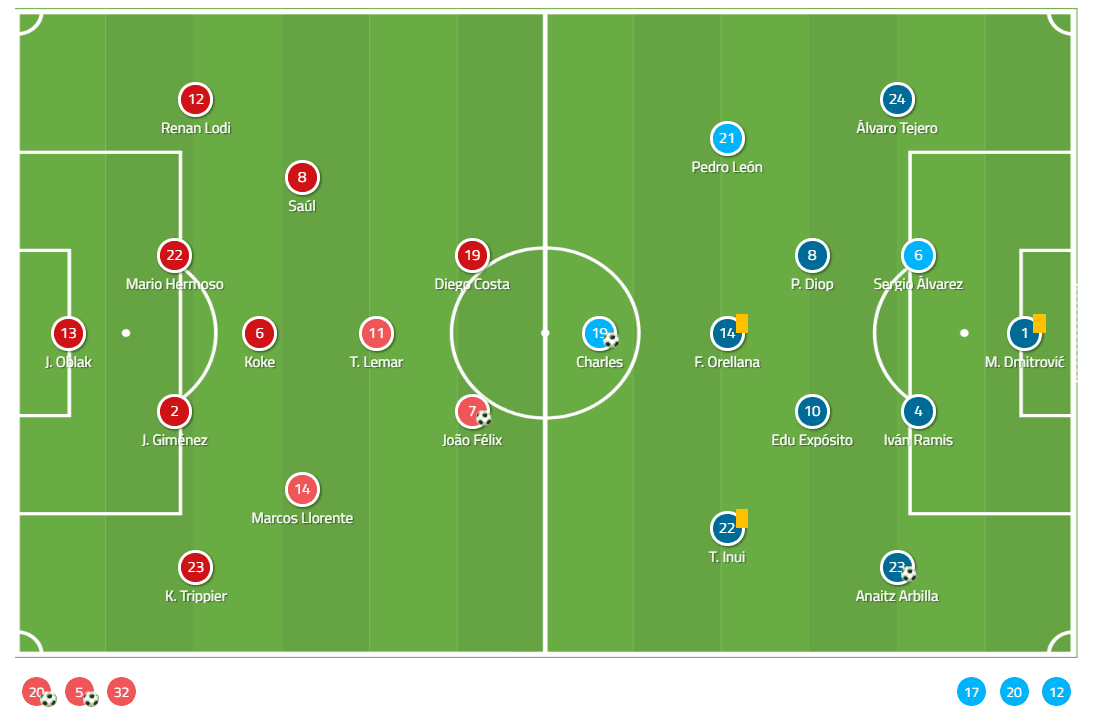
Simeone recalled Renan Lodi after his sending off on his debut, with Stefan Savic absent, whilst Diego Costa replaced the injured Álvaro Morata. Marcos Llorente also made his first start in place of Thomas Partey, who failed to impress against Leganés.
Mendilibar lined-up with a trusted 4-3-2-1 formation, with Takeshi Inui being given his first start of the season since returning to the club only a year after departing.
Eibar’s unsustainable press
From the very first whistle, it was clear that Eibar would look to play with intensity to unsettle an Atlético Madrid defence which was playing together for the first time. Without Savic and with Hermoso and Lodi playing together on the left, something which Simeone had yet to try this season, Eibar looked to capitalise on these nerves, pressing high in triangles which would block off passing routes whenever possible.
This was particularly deployed as the central defenders spread the ball wide to Kieran Trippier on the right and Lodi on the left, forcing both full-backs into rushed decisions and hopeful long-balls down the flank. It worked well, with six of Eibar’s eight interceptions in Atlético’s half coming in the first half. It was also essential to disrupting Atlético’s attempts to build up some flow and rhythm. Hermoso, in particular, was guilty of being panicked on the ball, resulting in him playing twice as many long passes as in his previous outing. This was key to Eibar’s plan of disrupting the Atlético system and instead focusing on making it an uncomfortable occasion for the home side, where some of their new, younger signings struggled with the pressure they came under.
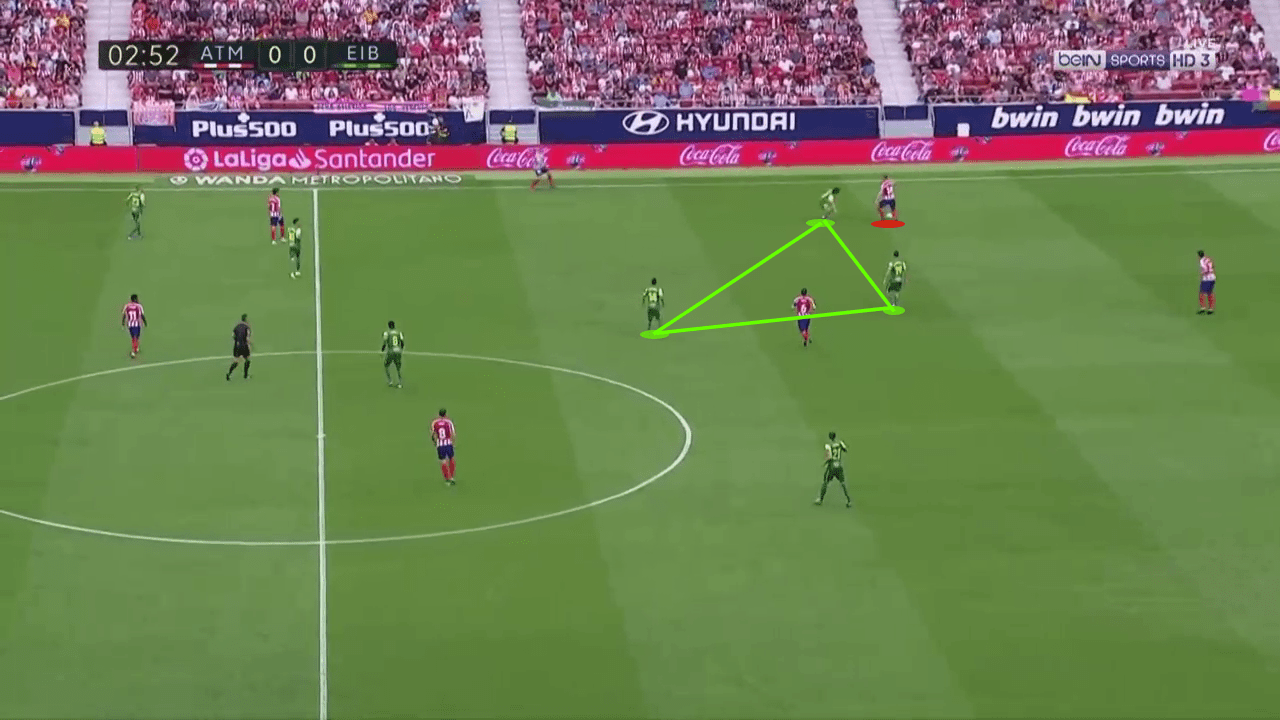
The issue came in that Eibar could not maintain this press and in the second half, it was particularly notable that the press could not be sustained. Instead, the front-line would drop deep with only one man, if that, pressing forwards to press. Very often, Eibar would be pinned back in their own half with no other option but to allow Atlético to play their own game around them. As such, it was little surprise to see the hosts come back into the game in the second half.
A focus on the left for Eibar
Another key point of Eibar’s game plan was to focus on Atlético’s left, again where Hermoso and Lodi lined up together, as a weak point. There, long balls were frequently played over the top, with 10 out of Eibar’s 20 positional attacks coming down their right wing, creating a substantial 97% of their xG and also producing both of their goals.
The first goal was the perfect illustration as the long ball caught Lodi out of position, forcing Hermoso to come across and cover. Marcos Llorente was also too far forward and unable to provide support to his defence, with him then being one of the Atleti players who were guilty of ball-watching as the ball made its way into the box, with the final run coming from deep through the middle with four players instead watching the man on the ball rather than Charles’ run in-behind.
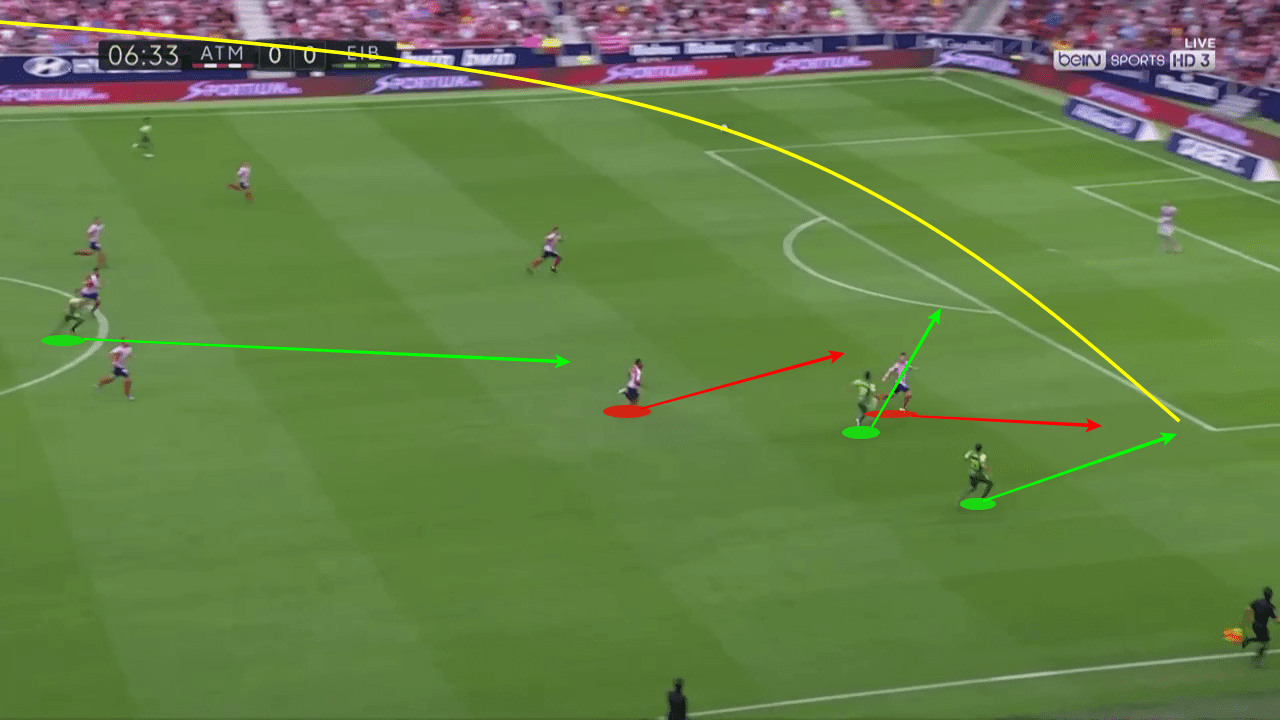
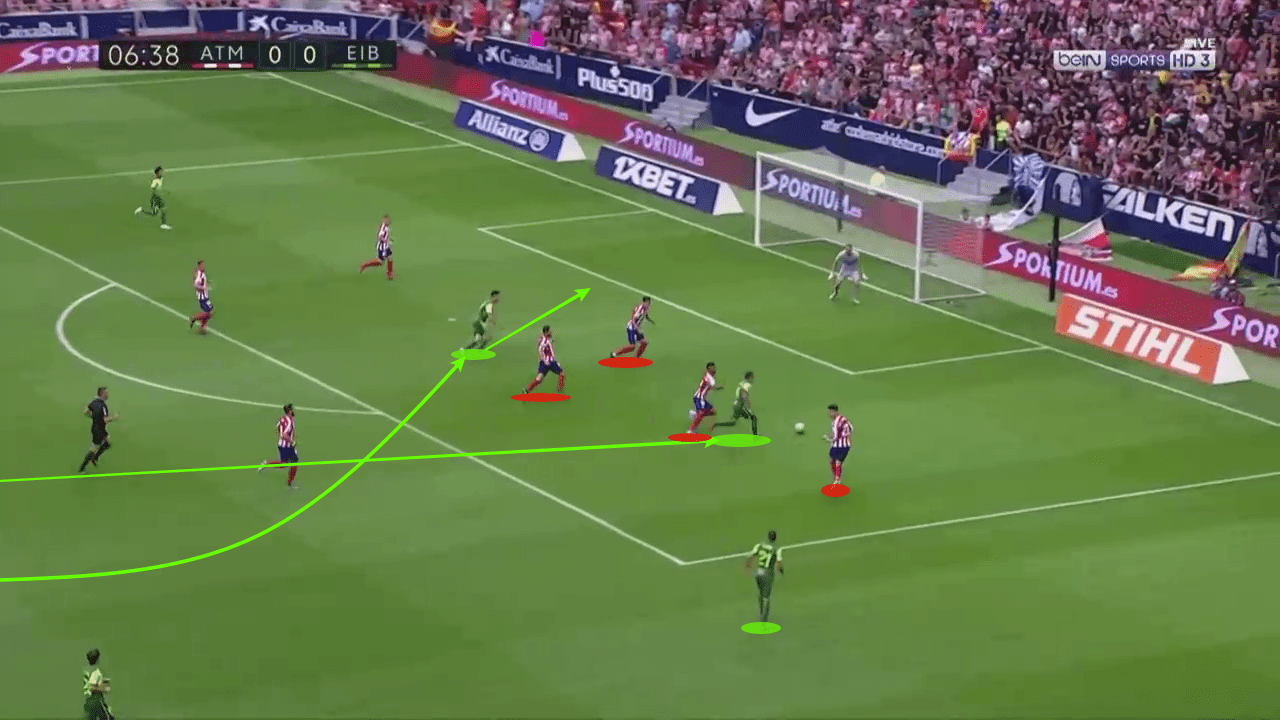
In the first half, this approach was essential as Eibar looked to shake up the Atlético Madrid defence and pull them all over the place. Particularly by capitalising on Lodi’s poor positioning, they were able to provide two superb chances which were comfortably converted. Whilst Trippier and José María Giménez offered experience on the right, that was absent on the left where Eibar continually looked to bombard long balls into spaces to exploit the weakness of the hosts.
And for Atlético too
In the second half, Simeone looked to use this strategy to his advantage. Lodi is far more comfortable when going forwards, yet was only used 50% of the time in the first half, with play more evenly distributed with more attacks coming down Trippier’s right hand side and through the middle. After the break, that changed, with all of Atlético’s second half xG from positional attacks coming down the left, with those increasing from 47% of attacks to 67% of attacks.
As Eibar pushed players forward to exploit the space in behind, Simeone would instruct his team to exploit the space left further forwards, with Lodi encouraged to get forward whenever he could. Vitolo was also introduced ahead of him, as will be touched upon, which gave him the left flank to roam freely with Saúl and Koke dropping into deeper midfield positions centrally allowing them to be able to drop to left-back and cover for the Brazilian if he was caught out.
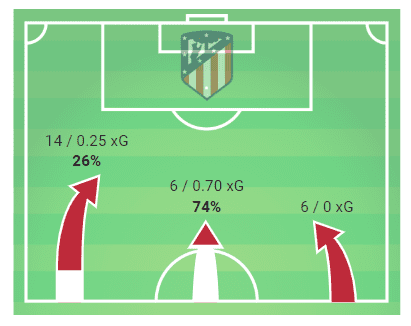
Lodi’s pace made an immediate impact and Atlético looked far more potent in attack with his contribution. Eibar had lined up with Fabio Orellana drifting towards the right but he became redundant with Lodi bypassing him on the counter each time that the ball was spread out to him, only really coming into play should the full-back cut inside or take a poor first touch. In total, Lodi made four progressive runs and four dribbles, with all but one coming in the second half as he was afforded greater freedom.
Vitolo’s introduction
Part of the unleashing of Lodi was to introduce Vitolo. Whilst he would usually be deployed as a left winger wide on the flank, he played more of a central role. His movement would allow Lodi to break forward down the wing, with Vitolo instead coming inside.
This was evident in his goal, the equaliser. Just as Eibar looked to pull the central defender away from the full-back for their efforts, Vitolo’s role was to do the same but with runs from deep. As the full-back would step-up, usually to close down Lodi, and often with the two central defenders distracted by Costa and Félix, Vitolo would immediately dart his run to exploit the space between the central defender and full-back. This is exactly what led to Atlético’s deserved equaliser.
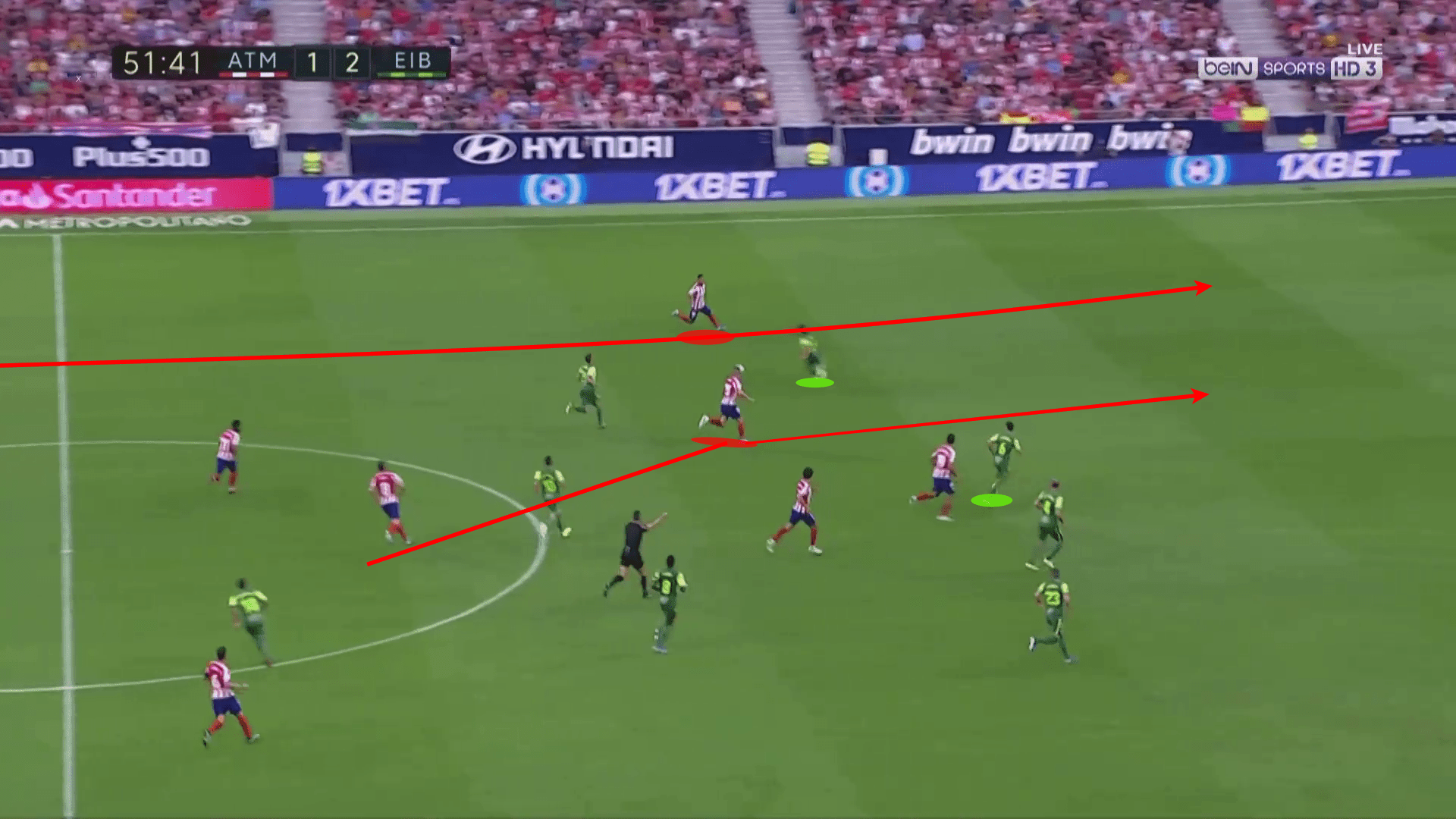
Simeone’s final substitution, the introduction of Partey, made a similar impact. The Ghanian was deployed in an offensive role, with the intention of picking up on the space in between the defensive and midfield lines of Eibar, something which he did well. Such recoveries at a stage when the game became increasingly scrappy with Eibar struggling to clear their lines were essential.
Conclusion
This analysis shows how Eibar started the game on the front foot with a superior tactical set-up which allowed them to capitalise on very few chances to take a substantial lead. However, an unsustainable approach, combined with Simeone’s inspired response, was crucial to Atlético regaining their foothold in the game. Once assured, the performances of substitutes were enough to guarantee a turnaround, with Simeone using Eibar’s own strategy to plot their downfall. It may not go down in the history books, but this was in fact one of Simeone’s greatest tactical masterminds of his era in the dugout of Atlético Madrid.

If you love tactical analysis, then you’ll love the digital magazines from totalfootballanalysis.com – a guaranteed 100+ pages of pure tactical analysis covering topics from the Premier League, Serie A, La Liga, Bundesliga and many, many more. Buy your copy of the August issue for just ₤4.99 here.

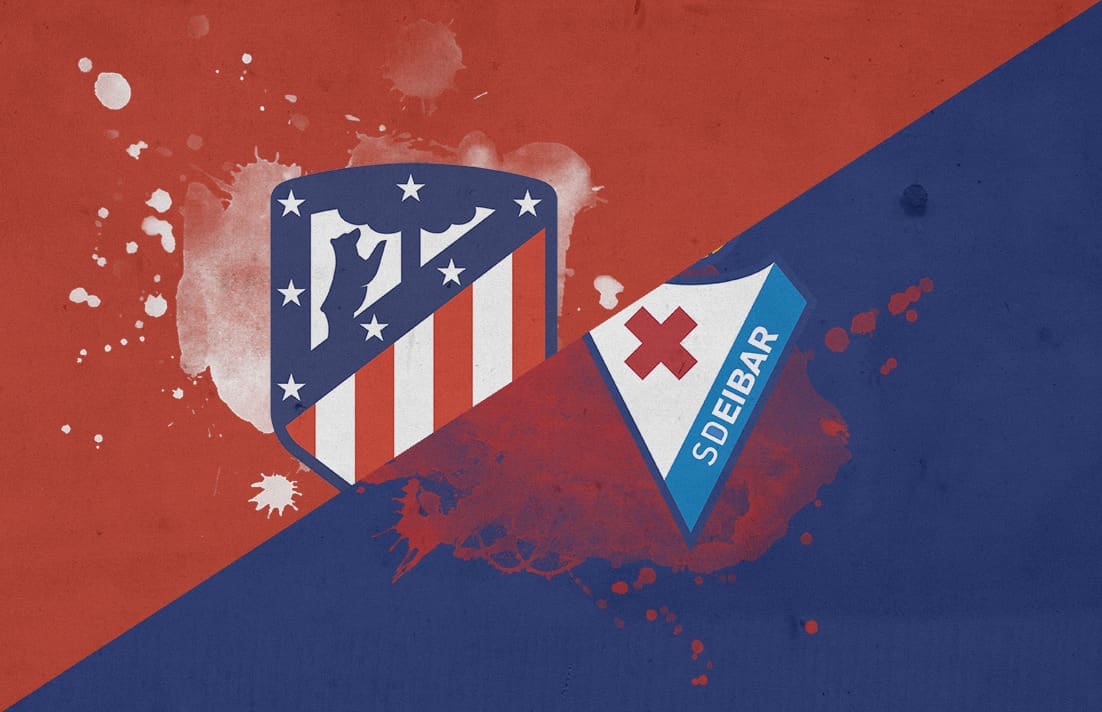



Comments